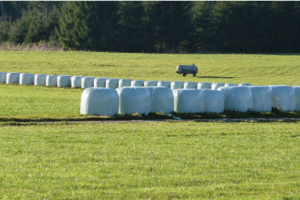Silage production is a cornerstone of livestock farming in Australia, providing essential nutrition to animals throughout the year. Central to the process of ensiling is the choice of silage wrap, a decision that significantly impacts feed quality, storage longevity, and, ultimately, farm profitability. With diverse climatic conditions and varying agricultural landscapes across the continent, Australian farmers must carefully consider their options when selecting silage wraps. In this article, we explore the range of silage wrap options available to Australian farms, considering factors such as climate resilience, durability, and cost-effectiveness.
 Understanding Silage Wrap:
Understanding Silage Wrap:
Silage wrap serves as a protective barrier around ensiled forage, creating an anaerobic environment essential for fermentation and preservation. By excluding oxygen and moisture, silage wrap inhibits microbial activity, preventing spoilage and maintaining feed quality over time. The choice of wrap material and technology significantly influences the efficiency and effectiveness of the ensiling process.
Options for Australian Farms:
Conventional Polyethylene (PE) Wrap:
- PE wrap is a widely used and cost-effective option for Australian farmers.
- It offers adequate moisture barrier properties, which are crucial for preserving forage quality in humid climates.
- However, PE wrap may be susceptible to tears and punctures during handling and storage, requiring careful attention to proper handling practices.
- While suitable for short-term storage, PE wrap’s vulnerability to UV degradation necessitates timely wrapping and sheltered storage to prevent deterioration.
High-Density Polyethylene (HDPE) Wrap:
- HDPE wrap represents an upgrade over conventional PE wrap, offering enhanced durability and UV resistance.
- Its robust construction reduces the risk of tears and punctures, ensuring better protection against external elements.
- With superior longevity, HDPE wrap is well-suited for long-term storage, providing reliable preservation of forage quality even in harsh Australian climates.
Oxygen Barrier Films:
- Oxygen barrier films incorporate advanced technologies to minimise oxygen permeation into silage bales, further enhancing preservation.
- Composed of multiple layers, including ethylene-vinyl alcohol (EVOH), these films offer superior protection against aerobic deterioration, making them ideal for high-moisture forages and prolonged storage durations.
- While oxygen barrier films deliver unparalleled performance, they typically come at a higher price point, necessitating careful consideration of cost-benefit analysis for individual farm operations.
Biodegradable Wraps:
- With growing environmental concerns, biodegradable silage wrap options have emerged as sustainable alternatives to traditional plastic wraps.
- Made from polymers derived from renewable resources, such as corn starch or sugarcane, these wraps offer effective ensiling capabilities while reducing environmental impact.
Factors Influencing Choice:
Climate and Environmental Conditions:
- Australia’s diverse climate zones, ranging from arid to temperate, necessitate careful consideration of wrap performance under varying environmental conditions.
- Regions experiencing high humidity may benefit from wraps with superior moisture barrier properties, such as PE or HDPE.
- Areas with intense sunlight require wraps with enhanced UV resistance to prevent degradation, favouring options like HDPE or oxygen barrier films.
Storage Duration:
- The intended duration of silage storage is a critical factor in selecting the appropriate wrap.
- Short-term storage may suffice with conventional PE wrap, while long-term storage requires more durable options like HDPE or oxygen barrier films to maintain feed quality over extended periods.
Farm-specific Requirements:
- Individual farm considerations, including budget constraints, labour availability, and sustainability goals, influence wrap selection.
- While cost-effective solutions like PE wrap may suit smaller operations with limited resources, larger farms aiming for optimal preservation and environmental stewardship may opt for premium options like HDPE or biodegradable wraps.
Choosing the right silage wrap is paramount for Australian farmers seeking to maximise feed quality and storage longevity. By considering factors such as climate resilience, durability, and cost-effectiveness, farmers can make informed decisions that align with their specific operational needs and sustainability objectives. Whether opting for conventional PE wrap, high-performance HDPE, oxygen barrier films, or eco-friendly biodegradable silage wrap options, the key lies in selecting the option that best suits the unique requirements of their farm while ensuring efficient ensiling practices and contributing to the long-term viability of their agricultural enterprise.
Advancements in silage wrapping have a direct impact on a farm’s productivity and forage quality. From the emergence of new types of plastic to the development of advanced machinery that makes it easier than ever to wrap bales, there are endless possibilities for improving the efficiency and nutritional value of an Australian forage crop.
